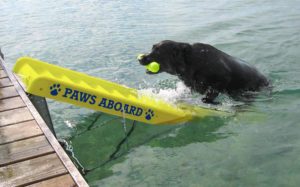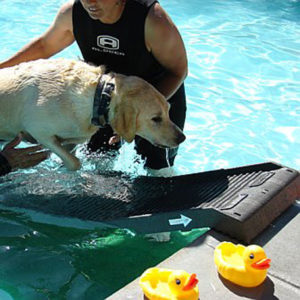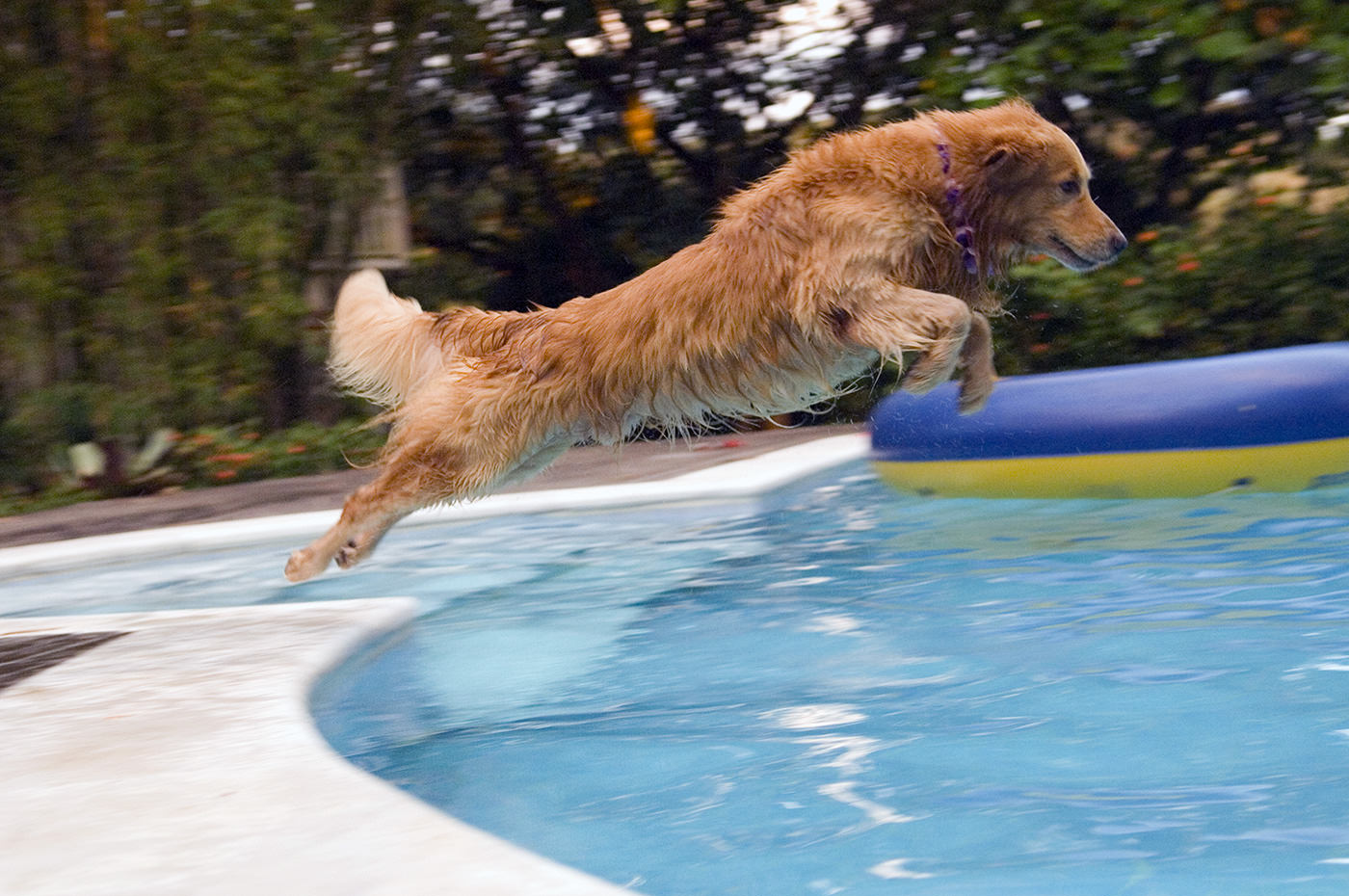With a seemingly endless stream of dogs-in-a-pool videos online it could be natural to assume that it’s all fun for all dogs to take a plunge. However, there are pros and cons along with health and safety concerns to consider before unleashing your pup into your pool water.
The Benefits of Swimming For Your Dog:
Just like for people, swimming for dogs is a great, low-impact total body workout. Swimming is easy exercise on your pet’s joints and limbs, which is terrific for both young pups and aging dogs alike. Swimming pools can be a fun place to play with the family in the water, or a rehabilitation method for a dog recovering from a procedure.
Swimming is an excellent workout for your dog’s cardiovascular system, as well. According to Dr. Arleigh Reynolds, a Veterinary Surgeon and Canine Physiologist, “1 minute of swimming is the equivalent to 4 minutes of jogging.” Not only is your dog getting a low-impact workout, it is getting more of a workout in a shorter period of time. However, just with any workout, it is best to slowly build your dog’s swimming sessions up in length. Short bursts of swimming at first, can gradually grow into longer workouts.
This is not to say that swimming is a substitute for all on-land workouts. It’s important to have a balance because running, jogging, and walking exercise helps maintain strong bone density.
Swimming pools are also a great way for your pup to cool off on a hot summer day. It’s always best to make sure that the water isn’t too cold or too warm as to not shock your dog as he or she enters the pool as this can frighten them. There’s no better way for your dog to cool off on a hot day than taking a plunge into cool water. From an exercise perspective, warmer water is better for your dog’s muscles to help promote a full range of movement and blood flow, which allows them to warm-up quicker and prevent muscle spasms.
A fit dog is a healthy dog that is less susceptible to injuries in the longrun. It’s even better if part of the fitness routine can be part of family bonding time while everyone is having fun in the pool.
Not All Dogs Are the Same:
It’s a common misconception that all dogs instinctively know how to swim. Some dogs are better equipped to swim based on their physical builds than others, and some dogs have had bad experiences that have made them scared of water in general.
Some dogs can swim like a pro almost instinctively, some dogs can be trained to swim, and some dogs are just not meant to be amphibious. The dogs that are born to swim generally have long, strong limbs or many have swimming in their genes and are bred to swim to retrieve ducks and waterfowl for hunting purposes. Some of them even have references to water in their names (always a good sign!).
Here’s a list of 10 Dog Breeds that are Great Swimmers:
- Chesapeake Bay Retrievers
- English Setters
- Irish Setters
- Irish Water Spaniels
- Golden Retrievers
- Labrador Retrievers
- Newfoundlands
- Nova Scotia Retrievers
- Portuguese Water Dogs
- Spanish Water Dogs
On the other side of things are dogs like bulldogs, pugs, and dachshunds. Their short legs simply can’t perform a strong doggie paddle and they struggle to create enough thrust to keep them on the water’s surface. Breeds with short faces like bulldogs or pugs have trouble keeping their snout out of the water. Smaller dogs may enjoy swimming but it is important to be aware that smaller dogs can get colder faster in chillier pool water or can panic by becoming overwhelmed from being in the pool.
Here’s a list of 10 Dog Breeds that are Not-Great Swimmers:
- Alaskan Malamutes
- Basset Hounds
- Bulldogs
- Chows
- Dachshunds
- Doberman Pinschers
- Pekingese
- Pugs
- Siberian Huskies
- Shih Tzu’s
This is not to say that your Pekingese will never be able to swim in your pool, or that your Spanish Waterdog is going to love the pool. It is good to have an understanding of what makes a dog a good swimmer or not. Of course, with the proper supervision and training, any dog of any breed can learn to swim.
For instance, I have a German Shepherd that absolutely loves to swim in ponds or lakes. He can even behave (for the most part) when it comes time to give him a bath. However, he will not go anywhere near my swimming pool. This brings us to #2 on our list: Pools can be difficult to get in and out of for your dog. Most pools do not have the gradual slope into deeper waters from the shallow end. They rely on steep steps for exiting and entry which can be very difficult for a dog to navigate especially when dealing with the stimulation and excitement of the water splashing all around.
If your dog isn’t the type to jump off of the pool deck into the water, or if he or she is too big to slowly carry into the water, it may take some slow-paced, quiet encouragement for your dog to trust the steps into the pool. It’s always good to have some treats on-hand to reward your dog’s first steps into the pool, and as we mentioned earlier, warm water is much more inviting for your pup.
Skamper Ramp Dog Step
 Skamper Ramp is the original pool exit ramp for dogs. Two sizes are available, for small dogs up to 50 lbs, and a larger Skamper Ramp for dogs up to 90 lbs. Attaches to your pool cover deck anchors, or you can install two small anchors in the pool deck to attach the dog ramp. Made of durable, impact resistant UV stabilized plastic with surface holes for traction.
Skamper Ramp is the original pool exit ramp for dogs. Two sizes are available, for small dogs up to 50 lbs, and a larger Skamper Ramp for dogs up to 90 lbs. Attaches to your pool cover deck anchors, or you can install two small anchors in the pool deck to attach the dog ramp. Made of durable, impact resistant UV stabilized plastic with surface holes for traction.
Paws Aboard Doggy Boat Ladder
 This pet pool ladder is designed with boats in mind but since it is constructed from durable rubber it works for pools too! It’s rust resistant, simply attaches to an existing people ladder, and has steps without spaces between, to serve as a solid staircase for your dog. It attaches to steps that are 14” wide and includes an attachment for wider steps. Best for dogs under 90 lbs.
This pet pool ladder is designed with boats in mind but since it is constructed from durable rubber it works for pools too! It’s rust resistant, simply attaches to an existing people ladder, and has steps without spaces between, to serve as a solid staircase for your dog. It attaches to steps that are 14” wide and includes an attachment for wider steps. Best for dogs under 90 lbs.
PetStep Dog Ramp
 The original PetStep Dog Ramp is heavier and can accommodate larger dogs at a maximum of 200 pounds. It floats and it is made of built-to-last plastic with a rubberized surface. It’s a bit heavier and a slightly bigger than most dog ramps but the extra strength could be the very thing that makes your pet feel secure and stable as it exits and enters your pool.
The original PetStep Dog Ramp is heavier and can accommodate larger dogs at a maximum of 200 pounds. It floats and it is made of built-to-last plastic with a rubberized surface. It’s a bit heavier and a slightly bigger than most dog ramps but the extra strength could be the very thing that makes your pet feel secure and stable as it exits and enters your pool.
Is Chlorine Bad for Dogs?
One of the obvious concerns dog owners have when debating whether or not it is safe for their dog to swim in a swimming pool is chlorine and other pool chemicals. Chlorine can slightly irritate a dog’s eyes or sensitive nose just like humans but a dip in the pool for a few hours on a sunny day is harmless. Just like humans, it is a good idea to shower (or hose) off after swimming so that the chlorine doesn’t dry out their skin and fur. Be sure to dry him or her off thoroughly, as well.
To prevent your dog’s fur from being stripped of its natural oils consider a leave-in conditioner spray like HappyTails Ruff to Smooth before and after a swim. Also, consider adding omega-3 fatty acid supplements to their diet to help regenerate oils lost from swimming.
If it’s at all possible, try to give your dog a quick hose down before entering the pool, too. This will help wash off any dirt and other undesirables from their fur as well help wash off some of their shedding fur. Which brings us to number 4 on our list.
Dog Hair and Nails in the Pool:
They say a dog is equivalent to about 50 people in the pool at one time. Crazy, huh? Notwithstanding, although dog hair and such is harder on a filter system, by no means are they known to do damage either. Your strainer basket will do most of the heavy work and you may need to do some extra skimming the following day once the hair settles. All-in-all, dog hair is a manageable byproduct that most pool owners find to be a minor inconvenience to letting their dog share in the joys of pool time.
Another concern that many pool owners initially have is whether or not their dog will scratch or tear their vinyl liner. If your dog is tall enough to stand on the pool floor, their nails are not known to damage the liner. Most dogs try to exit the pool the same way they came in, so scratching at the sides of the pool wall is not something that typically occurs. Through my online research I was not able to find any tales of dogs accidentally causing damage to pool liners.
While your vinyl liner may not have cause for concern, swimmers, especially younger swimmers should be aware of your dog’s nails. This may seem like common sense but I’ve seen it happen numerous times and no one is necessarily at fault in this situation: an eager child or person approaches the excited swimming dog as is scratched as they are approached. The dog’s swimming reflexes naturally create the same scratching or digging movement for their legs, and this can be compounded by the excitement of approaching a loved one in the pool.
Dogs Drinking Pool Water:
I have found several online references to dogs who drank large amounts of pool water, and then began throwing up. I’m not sure if it’s related to pool chemicals, or just to drinking too much water while swimming, but it seems to happen on occasion. You probably can’t train your dog to not drink pool water, but if your dog loves to drink the pool water and then develops tummy problems, you could try reducing chemical levels by adding a mineral purifier like Nature2 or Frog. Some dogs may learn from the experience, and avoid drinking pool water, but not all.
It’s inevitable that your dog will ingest a little bit of pool water, but if your dog is incessantly drinking the water, it may be a good idea to limit their swim time. Keeping a big bowl of fresh water nearby could help prevent them from drinking the pool water. Occasional drinks from a well-maintained pool are not harmful to most dogs but dogs with heart disease, kidney disease, and those eating salt-restricted diets should never drink from saltwater pools.
Dog Ear Infections from Swimming:
Last but certainly not least of our pros and cons list for letting your dog swim in your pool is the increased potential of your dog getting an ear infection. Swimming pools, no matter how well maintained, can be home to bacteria or other infection-causing germs that could create problems in your dog’s sensitive ear canals.
However, a little effort can go a long way to protect your pup’s ears from infections by simply cleaning and drying their ears thoroughly immediately after a swim with a cotton or wool towel. An extra-preventative measure would be to use HappyTails deodorizing ear wipes around the ear canal after a swim.
It’s always a good idea to use a gentle, weekly ear cleaner to clean your dog’s sensitive ears but it’s especially important if your dog is a regular swimmer. This can help remove any dirt, salt, or other pollutants that can build up over the course of a week.
There are many great benefits to encouraging your dog to swim with you in your pool! Putting your dog’s comfort and safety first should always be your primary objective and always go into it knowing that not all dogs are meant to swim, not all dogs like to swim, and some dogs just need the proper training to learn how to swim.
Feel free to leave a comment if you have a tip or a product that you think can help with swimming dogs! We love to hear from our pool community!


